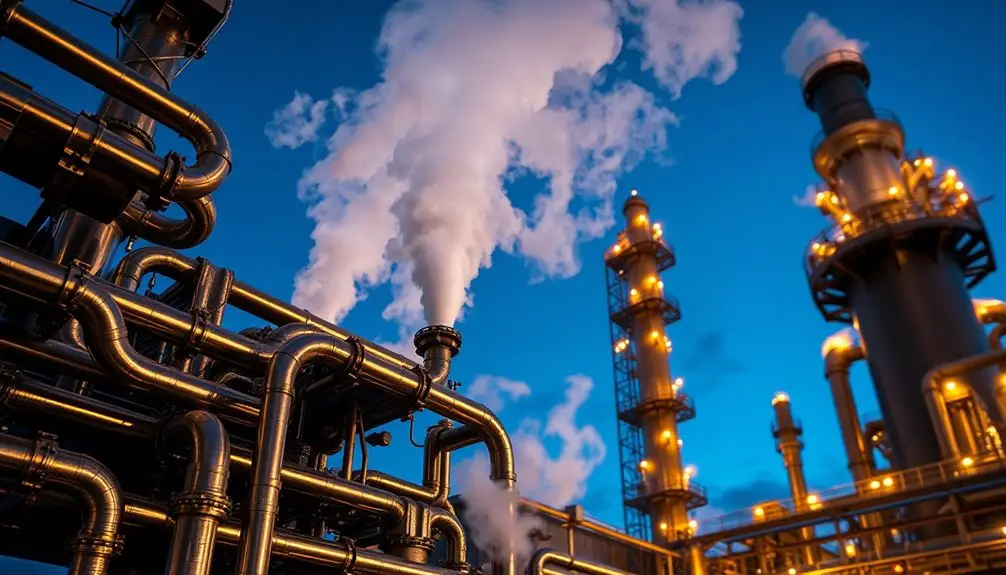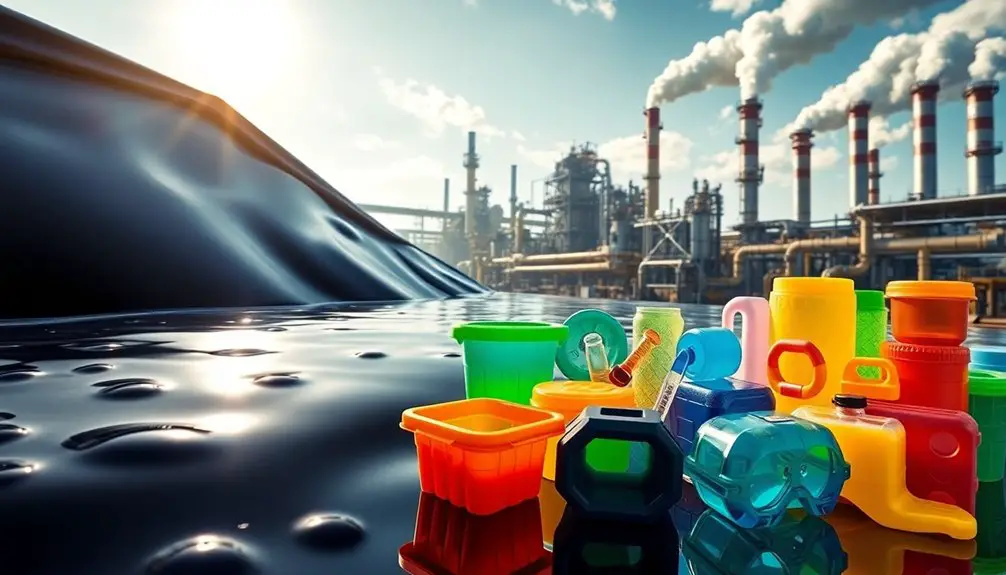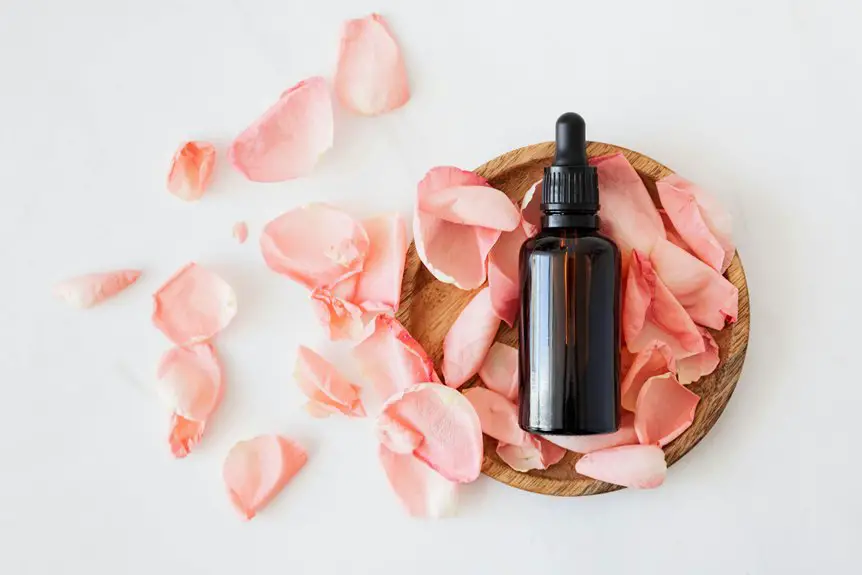To make polypropylene from crude oil, you start with the extraction and refining of crude oil, which produces a key fraction called naphtha. Then, through a process known as cracking, naphtha gets broken down into smaller hydrocarbons, mainly propylene. You can achieve this via steam or catalytic cracking. Next, polymerization links the propylene molecules into long chains, resulting in polypropylene. This versatile plastic finds use in various industries, from automotive to packaging. If you're curious about the specific applications and properties of polypropylene, there's more to uncover about its journey from crude oil to everyday products.
Key Takeaways
- Crude oil is extracted and refined through distillation to separate it into various fractions, including naphtha, essential for producing propylene.
- Naphtha undergoes cracking, breaking down larger hydrocarbons into smaller molecules, primarily producing propylene for further processing.
- Propylene is then polymerized, linking monomers into long chains to form polypropylene, using catalysts to influence the reaction.
- The polymerization process can be conducted through various methods, including bulk, solution, and gas-phase techniques, adjusting conditions for desired properties.
- Final polypropylene products are versatile, utilized in automotive, medical, packaging, textiles, and household items due to their durability and heat resistance.
Overview of Crude Oil
Crude oil, often found beneath the Earth's surface, is a vital natural resource composed mainly of hydrocarbons. This resource plays a crucial role in the petrochemical industry, where it serves as the primary source for producing propylene, a key monomer in the creation of polypropylene (PP). By understanding the significance of crude oil, you can appreciate its value as a raw material for various chemical products.
During the refining process, crude oil undergoes several transformations to yield valuable raw materials. One of the essential outputs of this process is naphtha, which is further processed into various petrochemicals.
Despite the potential for plastic production from these resources, only 4-6% of oil and gas reserves in Europe are currently utilized for that purpose. This limited use emphasizes the need for more efficient practices in the petrochemical sector, particularly in reducing plastic pollution and mitigating its devastating impact on marine ecosystems.
Additionally, it's essential to consider environmental factors associated with crude oil extraction, such as resource depletion and climate change impact, highlighting the necessity for sustainable practices within the industry.
Extraction and Refining Process
Understanding the extraction and refining process is key to grasping how crude oil transforms into valuable products like polypropylene. First, crude oil is extracted from beneath the Earth's surface through drilling. This black gold is primarily composed of hydrocarbons. Once extracted, the refining process begins, which involves distilling the crude oil to separate it into various fractions based on their boiling points.
Here's a simplified breakdown of the refining process:
| Step | Description |
|---|---|
| Extraction | Crude oil is drilled from underground deposits. |
| Distillation | Crude oil is heated to separate fractions. |
| Naphtha Production | Naphtha is one key fraction for petrochemicals. |
| Cracking | Larger hydrocarbons are broken down into smaller ones, producing propylene. |
| Polymerization | Propylene is transformed into polypropylene. |
During this process, naphtha is crucial as it will eventually undergo cracking, breaking down into smaller hydrocarbon molecules. The extracted propylene is then subjected to polymerization, forming polypropylene, a widely used plastic. This journey from crude oil to polypropylene showcases the importance of the extraction and refining processes.
Cracking to Produce Propylene

When it comes to producing propylene, cracking plays a pivotal role in transforming larger hydrocarbon molecules into smaller, more valuable compounds. This crucial petrochemical process breaks down crude oil through methods like steam and catalytic cracking. During cracking, crude oil is heated to high temperatures, causing it to decompose and yield key products, with propylene being one of the main byproducts.
Propylene primarily comes from the cracking of naphtha, a fraction derived from crude oil processing. The efficiency of the cracking process significantly affects the yield of propylene, making it essential for maximizing production in the petrochemical industry. In fact, the more efficient the cracking, the more propylene you can produce, which is vital for the next steps in creating polypropylene.
Once obtained, propylene is further processed through polymerization to form polypropylene, a versatile plastic that finds applications across various industries, including packaging, which often utilizes polypropylene (#5) for food containers due to its growing acceptance in recycling.
Understanding the importance of cracking not only highlights how propylene is generated but also underscores its role as a foundational building block in the production of polypropylene, paving the way for countless products you encounter daily.
Polymerization of Propylene
The polymerization of propylene kicks off a crucial process that turns individual propylene monomers into long-chain polymers known as polypropylene. This transformation happens through a chemical reaction that links these monomers, typically facilitated by a catalyst. The choice of catalyst plays a significant role in determining the properties of the final polypropylene product, allowing for the formation of a semi-crystalline structure that enhances strength and durability.
You'll find that polymerization can occur in various forms, including bulk, solution, and gas-phase methods. Each method influences the characteristics of the polypropylene produced. By adjusting reaction conditions like temperature and pressure, you can effectively control the molecular weight of the final chemical compound.
This control is vital, especially since polypropylene's high melting point—around 160-170°C—makes it suitable for applications that require heat resistance. Furthermore, a shift towards environmentally friendly alternatives to PVC, such as those made from BioPaper materials, highlights the importance of exploring sustainable options for plastic production.
Ultimately, this polymerization process is essential in converting crude oil-derived propylene into a versatile material that meets diverse needs, paving the way for numerous applications in everyday life.
Applications of Polypropylene

Polypropylene's versatility shines through in its wide-ranging applications across various industries.
In the automotive industry, you'll find polypropylene (PP) commonly used for manufacturing components like dashboards, bumpers, and interior elements. Its lightweight and durable properties make it an ideal choice for enhancing vehicle performance and safety.
In the medical field, polypropylene stands out due to its high chemical resistance and heat tolerance. This makes it perfect for applications such as syringes, medical devices, and sterilizable packaging, ensuring safety and reliability in healthcare settings.
The flexible packaging sector also benefits from polypropylene, as it serves as a cost-effective alternative to traditional materials. Its excellent moisture barrier properties help preserve food and consumer goods, ensuring they stay fresh and safe for longer periods. Furthermore, polypropylene's resistance to environmental elements, similar to plastic furniture's weather resistance, allows it to maintain its quality and functionality over time.
Additionally, polypropylene is present in textiles, especially in sportswear, where its resistance to liquid absorption and durability enhances comfort and performance.
You'll even find it in common household items like disposable cups, containers, and caps, showcasing its versatility and extensive use in everyday products.
Frequently Asked Questions
How Is Polypropylene Made From Crude Oil?
To make polypropylene from crude oil, you extract propylene through cracking, then polymerize it into long chains. This process creates a versatile plastic that's used in everything from packaging to medical devices, offering great heat resistance.
How to Turn Crude Oil Into Plastic?
To turn crude oil into plastic, you'll refine it through distillation, crack it into smaller molecules, and then polymerize those molecules into long chains. This process creates versatile plastics like polypropylene for various applications.
What Is the Natural Resource Used to Make Polypropylene?
To make polypropylene, you use propylene, which comes from crude oil. After extracting crude oil, the refining process separates it into fractions, with naphtha serving as a key feedstock for producing propylene.
How Is Polypropylene Produced?
You extract propylene from crude oil through cracking, breaking down larger hydrocarbons. Then, you polymerize the propylene, forming long chains to create polypropylene, which can be blended with additives for various applications.

